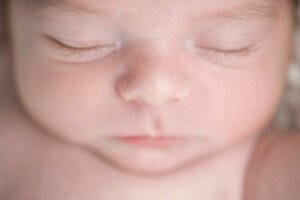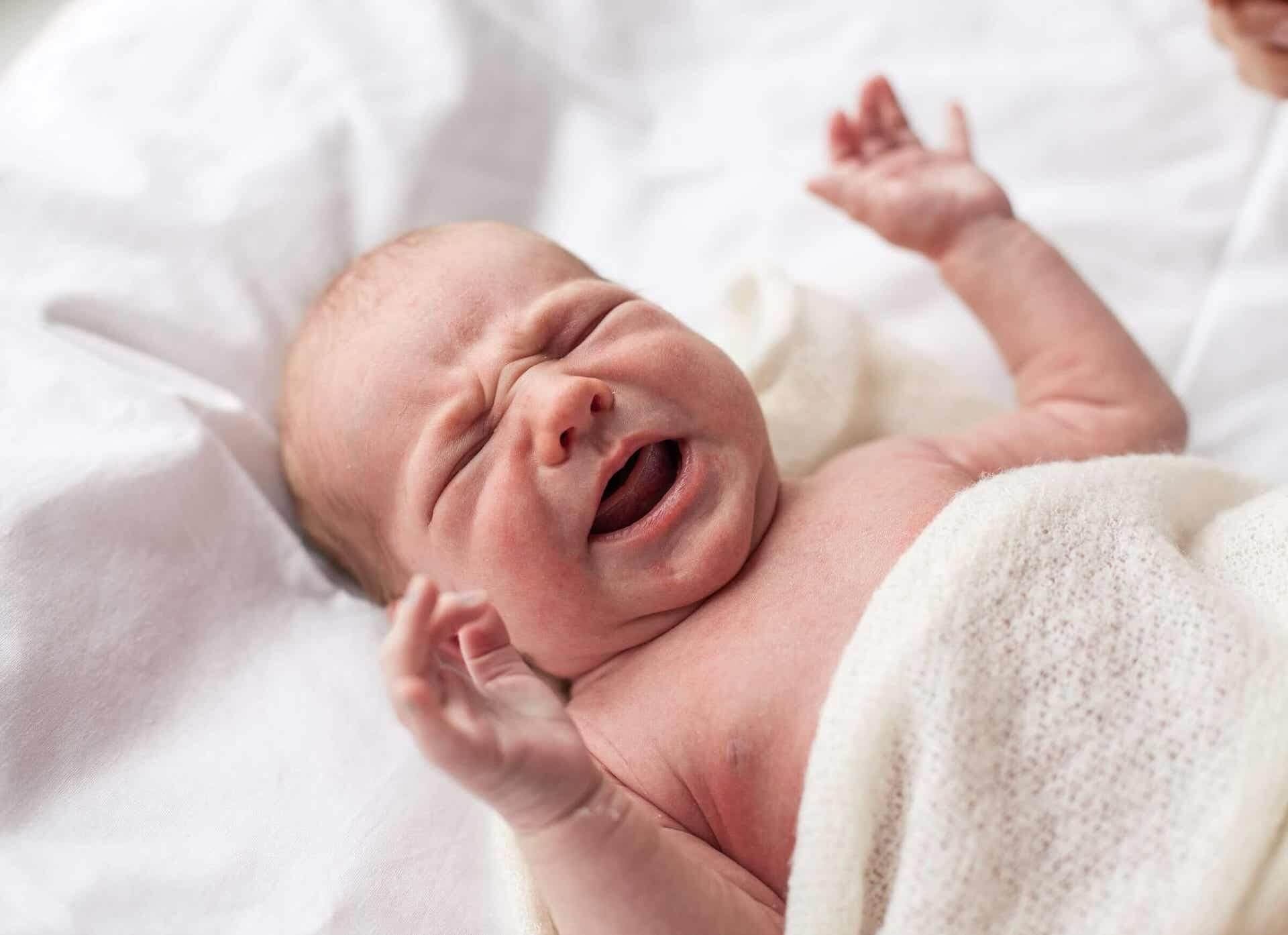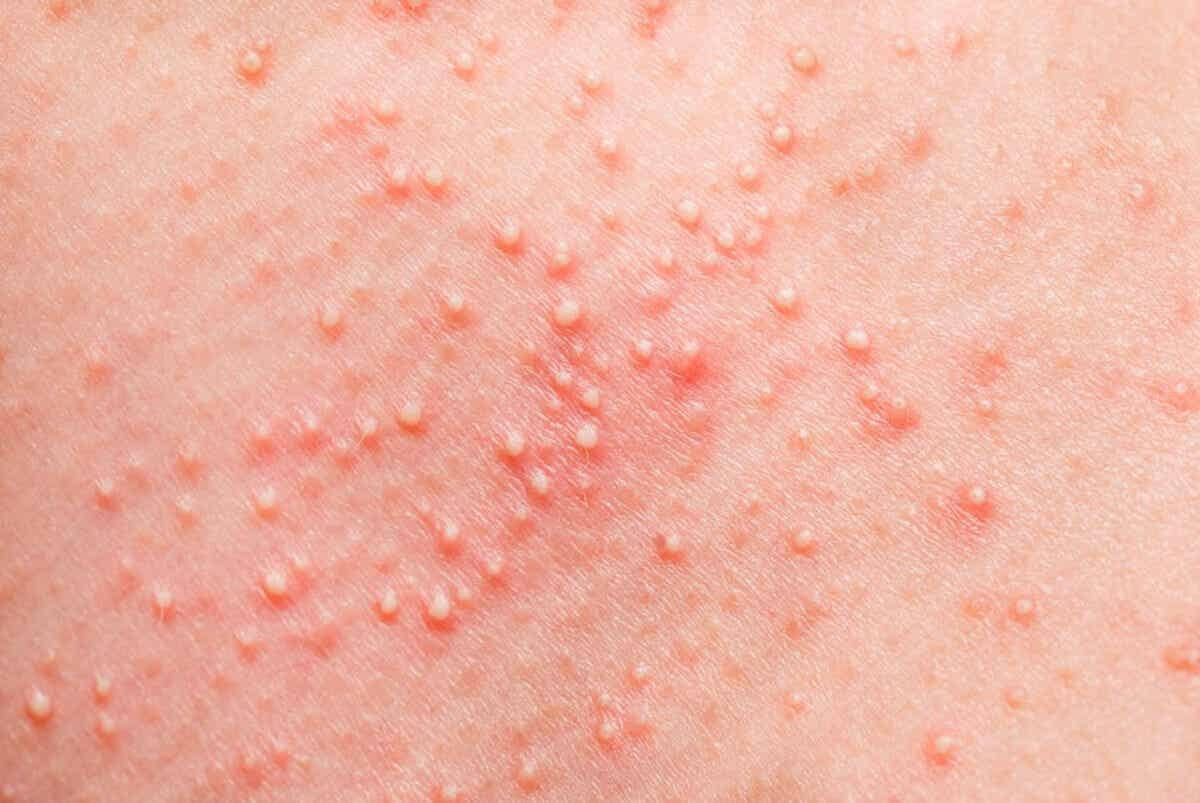Miliaria or Sweat Rash in Infants: What Is It?


Written and verified by the dermatologist Maria del Carmen Hernandez
The presence of miliaria, also known as heat rash or sweat rash in infants, is a condition that occurs quite frequently. In turn, it develops with greater predisposition in warm and humid climates during the summer months. It’s a self-limited manifestation of the cutaneous surface, which heals spontaneously and doesn’t depend on treatment.
The presence of miliaria or sweat rash in infants
Miliaria in infants occurs due to the obstruction of the eccrine sweat glands and ducts. Consequently, this triggers a reflux of sweat into the dermis.
That’s why this condition is also known as “sweat rash” or “heat rash.” In addition, the rash usually appears on the areas of the body where infants and children sweat most:
- Neck.
- Underarms.
- Groin.
- Back.
- Elbow creases and behind the knees.
When sweat stagnates in unsuited skin areas, a rash of tiny vesicles containing sweat appears.

Causes of sweat rash in infants
Even if this clinical condition can occur in any sex or age group, children and infants are more prone due to the immaturity of their sweat glands.
The main risk factor is sweating, so hot or humid conditions coupled with high body temperatures aren’t beneficial. In addition, there are other causes that may be related to this condition:
- Drugs that stimulate sweating.
- Intense exercise.
- Morvan’s syndrome (pathology related to hyperhidrosis).
- Occlusion of the skin surface.
Types of miliaria
There are different types of miliaria in infants that are classified according to the depth of the obstruction of the sweat gland duct. Moreover, these variants have different clinical and histological features.
Miliaria crystallina
Also known as sudamina, it’s characterized by its presence in newborns with higher incidence at 2 weeks of age or younger. Occlusion of the sweat gland occurs in the stratum corneum, on the surface of the skin.
Miliaria rubra or prickly heat
This is the most common form of miliaria and is most frequent among one-week and three-week-old newborns. Occlusion occurs in the ducts of the epidermis in the subcorneal layers. Unlike crystalline miliaria, this type of clinical picture may cause mild itchy skin.
Miliaria profunda
Of the three, this is the rarest form. It’s present in those who have recurrent episodes or who have been recently exposed to new warm climates. In addition, the most important cause is the occlusion of the sweat gland ducts at the dermoepidermal junction, in the papillary dermis. The vesicles are larger in size, harder and also flesh colored.
You may also read: Caring for Your Newborn Baby’s Skin
How does miliaria or sweat rash appear in babies?
Miliaria is a skin surface eruption that has its diagnosis based on physical and visual examination of the lesions. They involve papules, pustules and small vesicles. The rash usually appears within a few days of exposure to risk factors and will heal days after the surface layer has been removed.
According to the American Osteopathic College of Dermatology, when pustules are present, it’s called miliaria pustulosa and may be suggestive of a bacterial infection.
When the clinical manifestations involve high fever, intense pain, an associated respiratory condition or purulent discharge through the lesions, a physician should be consulted for evaluation and diagnosis.
Read also: How to Fight Skin Rashes in Babies?
Therapeutic options for miliaria or sweat rash in infants
The main measure to treat this manifestation is to avoid hot and sweaty conditions. Therefore, wear breathable clothing, circulate in cooler environments, remove products that obstruct the skin, such as patches or band-aids, and treat febrile illnesses.

Miliaria crystallina doesn’t usually require treatment and is self-limiting, healing within 24 hours. However, miliaria rubra requires the application of low potency corticosteroid creams to reduce inflammation.
Topical antibiotics are a good option when a superimposed bacterial infection develops in miliaria pustulosa.
Another correct measure to prevent this condition is to wear loose-fitting clothing made of moisture-wicking fabrics that help prevent the accumulation of sweat on the skin.
Regarding miliaria or sweat rash in infants
Miliaria is a benign, non-contagious dermatological condition that, even if it can occur in all age groups, it occurs more frequently in newborns and infants.
Also, the vast majority of cases of miliaria in infants heal spontaneously as risk factors decrease and they move to a less humid and cooler environment.
The presence of miliaria, also known as heat rash or sweat rash in infants, is a condition that occurs quite frequently. In turn, it develops with greater predisposition in warm and humid climates during the summer months. It’s a self-limited manifestation of the cutaneous surface, which heals spontaneously and doesn’t depend on treatment.
The presence of miliaria or sweat rash in infants
Miliaria in infants occurs due to the obstruction of the eccrine sweat glands and ducts. Consequently, this triggers a reflux of sweat into the dermis.
That’s why this condition is also known as “sweat rash” or “heat rash.” In addition, the rash usually appears on the areas of the body where infants and children sweat most:
- Neck.
- Underarms.
- Groin.
- Back.
- Elbow creases and behind the knees.
When sweat stagnates in unsuited skin areas, a rash of tiny vesicles containing sweat appears.

Causes of sweat rash in infants
Even if this clinical condition can occur in any sex or age group, children and infants are more prone due to the immaturity of their sweat glands.
The main risk factor is sweating, so hot or humid conditions coupled with high body temperatures aren’t beneficial. In addition, there are other causes that may be related to this condition:
- Drugs that stimulate sweating.
- Intense exercise.
- Morvan’s syndrome (pathology related to hyperhidrosis).
- Occlusion of the skin surface.
Types of miliaria
There are different types of miliaria in infants that are classified according to the depth of the obstruction of the sweat gland duct. Moreover, these variants have different clinical and histological features.
Miliaria crystallina
Also known as sudamina, it’s characterized by its presence in newborns with higher incidence at 2 weeks of age or younger. Occlusion of the sweat gland occurs in the stratum corneum, on the surface of the skin.
Miliaria rubra or prickly heat
This is the most common form of miliaria and is most frequent among one-week and three-week-old newborns. Occlusion occurs in the ducts of the epidermis in the subcorneal layers. Unlike crystalline miliaria, this type of clinical picture may cause mild itchy skin.
Miliaria profunda
Of the three, this is the rarest form. It’s present in those who have recurrent episodes or who have been recently exposed to new warm climates. In addition, the most important cause is the occlusion of the sweat gland ducts at the dermoepidermal junction, in the papillary dermis. The vesicles are larger in size, harder and also flesh colored.
You may also read: Caring for Your Newborn Baby’s Skin
How does miliaria or sweat rash appear in babies?
Miliaria is a skin surface eruption that has its diagnosis based on physical and visual examination of the lesions. They involve papules, pustules and small vesicles. The rash usually appears within a few days of exposure to risk factors and will heal days after the surface layer has been removed.
According to the American Osteopathic College of Dermatology, when pustules are present, it’s called miliaria pustulosa and may be suggestive of a bacterial infection.
When the clinical manifestations involve high fever, intense pain, an associated respiratory condition or purulent discharge through the lesions, a physician should be consulted for evaluation and diagnosis.
Read also: How to Fight Skin Rashes in Babies?
Therapeutic options for miliaria or sweat rash in infants
The main measure to treat this manifestation is to avoid hot and sweaty conditions. Therefore, wear breathable clothing, circulate in cooler environments, remove products that obstruct the skin, such as patches or band-aids, and treat febrile illnesses.

Miliaria crystallina doesn’t usually require treatment and is self-limiting, healing within 24 hours. However, miliaria rubra requires the application of low potency corticosteroid creams to reduce inflammation.
Topical antibiotics are a good option when a superimposed bacterial infection develops in miliaria pustulosa.
Another correct measure to prevent this condition is to wear loose-fitting clothing made of moisture-wicking fabrics that help prevent the accumulation of sweat on the skin.
Regarding miliaria or sweat rash in infants
Miliaria is a benign, non-contagious dermatological condition that, even if it can occur in all age groups, it occurs more frequently in newborns and infants.
Also, the vast majority of cases of miliaria in infants heal spontaneously as risk factors decrease and they move to a less humid and cooler environment.
All cited sources were thoroughly reviewed by our team to ensure their quality, reliability, currency, and validity. The bibliography of this article was considered reliable and of academic or scientific accuracy.
- Carter R 3rd, Garcia AM, Souhan BE. Patients presenting with miliaria while wearing flame resistant clothing in high ambient temperatures: a case series. J Med Case Rep. 2011 Sep 22;5:474. doi: 10.1186/1752-1947-5-474. PMID: 21939537; PMCID: PMC3195105.
- Goyal T, Varshney A, Bakshi SK. Incidence of Vesicobullous and Erosive Disorders of Neonates: Where and How Much to Worry? Indian J Pediatr. 2011 Oct 25. doi: 10.1007/s12098-011-0592-9. Epub ahead of print. PMID: 22037857.
- Guerra KC, Toncar A, Krishnamurthy K. Miliaria. 2020 Aug 13. In: StatPearls [Internet]. Treasure Island (FL): StatPearls Publishing; 2020 Jan–. PMID: 30725861.
- Horcajada-Reales C, Conde-Montero E, Campos-Domínguez M, Suárez-Fernández R. Miliaria cristalina [Crystalline miliaria]. Med Clin (Barc). 2014 Aug 19;143(4):190. Spanish. doi: 10.1016/j.medcli.2014.03.017. Epub 2014 Jun 2. PMID: 24889747.
This text is provided for informational purposes only and does not replace consultation with a professional. If in doubt, consult your specialist.








